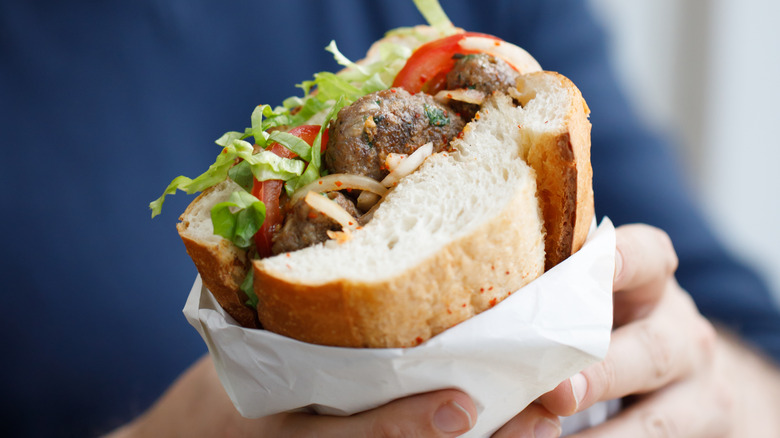The Healthiest Fast Food Sandwiches You Can Buy, According To Our Nutritionist
Fast food is a controversial topic in health circles. Some of the main concerns include the fact that it is mass produced with convenience in mind and often loaded with sodium, sugars, and unhealthy fats.
But according to Head of Nutrition for Nucific, Dr. Amy Lee, speaking exclusively with Health Digest, you can find relatively healthy options in the form of sandwiches at certain fast food chains. For the sake of clarity and to assuage any qualms about the distinction, we're grouping regular sandwiches, burgers, and submarines into the term sandwiches.
If you're looking for tips to help you move toward a healthier diet, "the best would be a freshly made sandwich from places such as Jersey Mike's and/or Subway, if I have to pick among the popular chains," explained Dr. Lee, adding that her reason for choosing these outlets has to do with their fresh vegetables, deli meats, and superior cheese options. Serving Northeast-American style sub sandwiches, Jersey Mike's has been recommended by other health professionals too. Subway has been commended for its use of fresh vegetables and in-house meat slicers that circumvent the problem of using pre-cut meat from factories.
What makes some sandwiches healthier than others?
How your food is prepared has a role to play when it comes to choosing a diet that's best for you, and the same can be said about fast food sandwiches. "The way it is prepped can make a difference. I have nothing against a good burger, but sometimes, the meats aren't the best quality and packed with saturated fats and or it is charred to a degree that it may contain bad byproducts," explained Dr. Amy Lee.
Even when it comes to deli meats, there are some that are healthier alternatives than the rest. For example, freshly cut lean meats like turkey, chicken breast, or roast beef are better than prepackaged lunch meat or highly processed bologna, salami, pepperoni, and pastrami. The more organic and minimally processed, the better. It might also help to know what ingredients go into your deli meat: the fewer the ingredients, the healthier it will be.
Additionally, portion sizes, which directly impact how many calories you're consuming, also make a difference. Supersizing, the concept of upping your portions to larger sizes, can be detrimental diet-wise, per the expert. "So when one meat patty is a standard portion size, you are now eating two or three patties stuffed between layers of cheeses which can bump over the caloric intake easily. For example, a standard portion size is a 6-inch sandwich vs. a foot long; but we are given this impression that we should eat the whole foot long," shared the nutritionist.
What should one look for when buying fast food sandwiches?
Assessing the macronutrient profile — proteins, carbohydrates, and fats — and the total number of calories is a good place to start, according to Dr. Amy Lee. This includes the entire meal, not just the sandwich — so we're talking sandwich, fries and any other sides, and the beverage. "A typical meal really shouldn't be more than 700-800 calories. Oftentimes, the fountain drink can contain as many as 300-400 calories which can be a meal for an individual," added the nutritionist. These are the things you should consider when you're figuring out, for example, the lowest-calorie sandwich you can order at Subway.
Resisting the urge to supersize is another good tip, per the expert. The goal is to eat until you are comfortably satiated, not stuffed and uneasy. Finally, she advises to "pick healthier side options; especially when there [are] vegetables, salads, or fruits." Subway's smashed avocado and unsweetened applesauce are some examples. Steer clear of fast food items with way more calories than you expected.
At the end of the day, it is difficult to beat the convenience of fast food. You don't have to eschew all of them all the time, even if you're on a diet of healthy eating. The trick is to pick the best options and also be mindful of where your fast food (and its ingredients) are coming from, how they're prepped, and how they're served to you.



